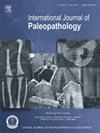Evidence of interpersonal violence through nasal fractures in Late Holocene Southern Patagonia
IF 1.5
3区 地球科学
Q3 PALEONTOLOGY
引用次数: 0
Abstract
Objective
To analyse the prevalence of nasal fracture among individuals from Southern Patagonia and to identify nasal fracture patterns that may reflect interpersonal violence at the population level, differentiating between pre- and post-contact periods.
Material
98 adults (males and females) dated to the Late Holocene period (4200 B.P.– present) from all Southern Patagonia ecogeographic subregions.
Methods
Facial bones were macroscopically examined for side of the fracture, direction of the deviation of the nasal bones and/or frontal processes of the maxilla, type of fracture (e.g. transverse, longitudinal), presence/absence of other facial fractures, and bone remodelling.
Results
Nasal fractures were identified in fifteen individuals (15.3 %), and were more frequent in males, particularly those from the Estrecho de Magallanes region. Comparisons revealed a significantly higher frequency among pre-contact individuals (23.8 % vs. 2.6 %; p = 0.0184).
Conclusions
This study documents the highest frequency of nasal fracture reported to date in South America’s bioarcheological record. Contrary to expectations, pre-contact individuals had a significantly higher frequency, suggesting a possible shift in violence dynamics following foreign contact.
Significance
This study provides insight into patterns of violence potentially linked to changes in pre and post-colonial life in Southern Patagonia and represents one of the first population-level biocultural approaches to interpersonal violence in the region.
Limitations
Analyses are limited due to the reduced number of individuals by sex, subregion, subsistence strategy, and period. Comparisons are hindered by the methodological heterogeneity of other studies on interpersonal violence in Patagonia and South America.
晚全新世南巴塔哥尼亚地区鼻腔骨折的人际暴力证据。
目的:分析南巴塔哥尼亚个体鼻骨折的患病率,并识别可能反映人群层面人际暴力的鼻骨折模式,区分接触前后时期。资料:来自南巴塔哥尼亚生态地理分区的98具成虫(男性和女性),年代为全新世晚期(4200 B.P.至今)。方法:对面骨进行宏观检查,包括骨折的侧面、鼻骨和/或上颌骨额突偏离的方向、骨折类型(如横向、纵向)、有无其他面骨骨折以及骨重建。结果:鼻腔骨折15例(15.3 %),男性更常见,尤其是来自Estrecho de Magallanes地区的男性。比较显示,接触前个体的频率显著更高(23.8 % vs. 2.6 %; = 0.0184页)。结论:本研究记录了迄今为止在南美洲生物考古记录中报道的鼻部骨折的最高频率。与预期相反,接触前的个体的频率明显更高,这表明在与外国接触后,暴力动态可能会发生变化。意义:该研究提供了对南巴塔哥尼亚殖民前后生活变化的潜在暴力模式的见解,并代表了该地区第一个人口层面的人际暴力生物文化方法之一。局限性:由于按性别、分区域、生存策略和时期划分的个体数量减少,分析受到限制。巴塔哥尼亚和南美洲其他关于人际暴力的研究方法的异质性阻碍了比较。
本文章由计算机程序翻译,如有差异,请以英文原文为准。
求助全文
约1分钟内获得全文
求助全文
来源期刊

International Journal of Paleopathology
PALEONTOLOGY-PATHOLOGY
CiteScore
2.90
自引率
25.00%
发文量
43
期刊介绍:
Paleopathology is the study and application of methods and techniques for investigating diseases and related conditions from skeletal and soft tissue remains. The International Journal of Paleopathology (IJPP) will publish original and significant articles on human and animal (including hominids) disease, based upon the study of physical remains, including osseous, dental, and preserved soft tissues at a range of methodological levels, from direct observation to molecular, chemical, histological and radiographic analysis. Discussion of ways in which these methods can be applied to the reconstruction of health, disease and life histories in the past is central to the discipline, so the journal would also encourage papers covering interpretive and theoretical issues, and those that place the study of disease at the centre of a bioarchaeological or biocultural approach. Papers dealing with historical evidence relating to disease in the past (rather than history of medicine) will also be published. The journal will also accept significant studies that applied previously developed techniques to new materials, setting the research in the context of current debates on past human and animal health.
 求助内容:
求助内容: 应助结果提醒方式:
应助结果提醒方式:


